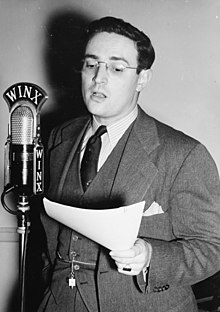| William P. Gottlieb | |
|---|---|
 Gottlieb at WOOK radio station, Washington, c. 1940 Gottlieb at WOOK radio station, Washington, c. 1940 | |
| Born | William Paul Gottlieb January 28, 1917 Brooklyn, New York, U.S. |
| Died | April 23, 2006(2006-04-23) (aged 89) Great Neck, New York, U.S. |
| Occupation(s) | Photographer, journalist |
| Children | 4 |
William Paul Gottlieb (January 28, 1917 – April 23, 2006) was an American photographer and newspaper columnist who is best known for his classic photographs of the leading performers of the Golden Age of American jazz in the 1930s and 1940s. Gottlieb's photographs are among the best known and widely reproduced images of this jazz era.
Gottlieb took pictures of hundreds of prominent jazz musicians and personalities, typically while they were playing or singing at well-known New York City jazz clubs. His subjects included Louis Armstrong, Duke Ellington, Charlie Parker, Billie Holiday, Dizzy Gillespie, Earl Hines, Jo Stafford, Thelonious Monk, Stan Kenton, Ray McKinley, Benny Goodman, Coleman Hawkins, Louis Jordan, Ella Fitzgerald, Toots Thielemans, Cab Calloway, and Benny Carter. In accord with his wishes, Gottlieb's photographs were placed in the public domain in 2010; many are used in Misplaced Pages and other public domain or freely licensed venues.
Biography

Gottlieb was born on January 28, 1917, in the Canarsie neighborhood of Brooklyn, and grew up in Bound Brook, New Jersey where his father was in the building and lumber business. He graduated from Lehigh University in Bethlehem, Pennsylvania in 1938 with a degree in economics. While at Lehigh, Gottlieb wrote for the weekly campus newspaper and was the editor-in-chief of The Lehigh Review. In his last year of college, he began writing a weekly jazz column for The Washington Post. While writing for the Post, Gottlieb taught economics at the University of Maryland in College Park, Maryland southwest of Baltimore. After the Post determined that it would not pay a photographer to accompany Gottlieb on his visits to jazz clubs, Gottlieb borrowed a press camera and began taking pictures for his column.
Gottlieb was drafted into the Army Air Corps in 1943 and served as a photography and a classifications officer. After World War II, Gottlieb moved to New York City to pursue a career in journalism. He worked as a writer-photographer for Down Beat magazine and his work appeared frequently in Record Changer, the Saturday Review, and Collier's. In 1948, Gottlieb retired from jazz journalism in order to spend more time with his wife, Delia, and their children. After William left Down Beat, he began working at Curriculum Films, an educational filmstrip company. He founded his own filmstrip company which was later bought by McGraw Hill. Many of his filmstrips won awards from the Canadian Film Board and the Educational Film Librarians Association. He also wrote and illustrated children's books including several Golden Books like The Four Seasons, Tigers Adventure, and Laddie the Superdog. He wrote educational books such as Science Facts You Won't Believe and Space Flight.

Apart from his photography career, William Gottlieb also played amateur tennis. He and his son Steven were often ranked the number one father-and-son team on the East Coast, and were twice ranked among the top ten teams in the US.
William Gottlieb was married to Delia Potofsky, the daughter of Jacob Potofsky. They had four children, Barbara, Steven, Richard, and Edward. William died of complications from a stroke on April 23, 2006, in Great Neck, New York.
References
- ^ Douglas Martin (April 25, 2006). "William Gottlieb, 89, Jazz Photographer". New York Times. Retrieved October 8, 2010.
- Teachinghistory.org
- "Photographs from the Golden Age of Jazz The William P. Gottlieb Collection at the Library of Congress". Library of Congress. Retrieved November 9, 2010.
- "Rights and Access | About this Collection | William P. Gottlieb Collection | Digital Collections | Library of Congress". Library of Congress, Washington, D.C. 20540 USA. Retrieved July 16, 2024.
- "Collection: William P. Gottlieb negatives | Archival Collections". archives.lib.umd.edu. Retrieved July 30, 2020.
- William P. Gottlieb Archived June 5, 2011, at the Wayback Machine, AllAboutJazz, accessed November 9, 2010
- "UVA Library". www2.lib.virginia.edu.
- Thurber, Jon (April 25, 2006). "William P. Gottlieb, 89; Jazz Journalist's Photos of Performers Captured a Golden Age of Music". Los Angeles Times. Retrieved June 14, 2024.
External links
| Archives at | ||||||
|---|---|---|---|---|---|---|
|
||||||
| How to use archival material |
- William P. Gottlieb Collection at the Library of Congress
- Jazzphotos.com
- Archive.org
- LOC gallery William P. Gottlieb
- Interviewed William Gottlieb for Jerry Jazz Musician
- Bound Brook High School Alumni Association and Hall of Fame